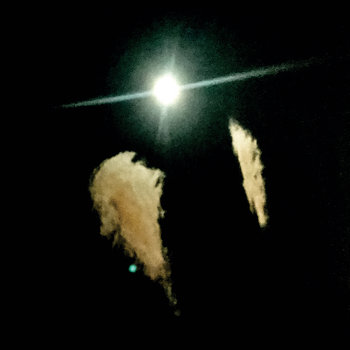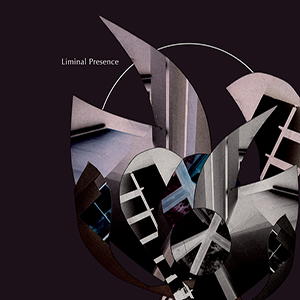- Administrator
- Albums and Singles

As Midwife, Denver based multi-instrumentalist Madeline Johnston plays what she describes as "Heaven Metal," or emotive music about devastation. Johnston began developing the experimental pop project in 2015 while a resident of beloved Denver DIY space Rhinoceropolis. The venue/co-op started in the early aughts and nurtured local artists until 2016, when its doors were shuttered due to high tensions surrounding the safety of DIY spaces (not coincidentally following the horrific Ghost Ship fire in Oakland). Residents were displaced around Denver and artists like Midwife were forced to start over.
However, it was at Rhinoceropolis that Madeline became close with Colin Ward, an artistic confidant and friend to whom her new album, Forever, is dedicated. Madeline comments, "He was my roommate and was the embodiment of that place [Rhinoceropolis] in a lot of ways. We became really close friends there. I was always learning so much from him, about life and being an artist. He was an amazing teacher and friend to me." When Ward passed away unexpectedly in 2018, she turned towards sound to express the indescribable feelings that partnered with her grief.
These mournful sounds ultimately developed into her new album, Forever. The 6-song LP is a latticework of soft-focus guitars and precise melodies– anthems of light piercing through gray clouds of drone. On the track "C.R.F.W.," we hear Colin Ward reading a poem that speaks of a leaf falling from a tree in autumn: "imagine the way a breeze feels against your leaf body while you finally don't have to hold on anymore." Johnston responds with slowly radiating tones, branches stretching out to hold the leaf one last time. "I wanted to write him a letter. I wanted to make something for him in his memory," Madeline says of Forever.
On Forever, Midwife combines ambient and dream pop into nuanced, reverb-soaked music that is equally haunting and moving.
More information can be found here.
Read More
- Administrator
- Albums and Singles

Matt Jencik is back on Hands in the Dark with his new album, Dream Character, the follow up to his first solo record Weird Times back in 2017.
Whilst all the songs on his debut album were created using the same sampling method on the same instrument, this time the Chicago artist's approach is slightly different. Using a combination of 4-track cassette, digital recording & sampling, he added live improvisations and a wider selection of instruments including guitar, bass, organ and string synth to his work.
What Matt Jencik achieves on Dream Character this time is, like a powerful dose of psychedelic drugs, not to be taken lightly. There are layers, and if you're prepared to dig you will find yourself drawn into a maze of pathways that can take you in multiple directions, via feelings of escape and release alongside suffocating claustrophobia, or soaring, triumphant beauty paired with cold, lonely despair. These eight titles can both tuck you in and make you feel like you’ve got to fight your way out. Either way there is great value in the experience. There is a purity and a clarity to Jencik's sound, but one that can only truly be accessed by listening with your own intention.
More information can be found here.
Read More
- Administrator
- Albums and Singles

Sound In Silence is happy to announce the return of Test Card, presenting his new album Music For The Towers.
This is his second release on the label after the highly acclaimed, and already sold out, album Rediffusion back in 2017.
Test Card is the solo project of Lee Nicholson, based in Vancouver, Canada. Nicholson was a member of Preston’s Formula One in late 1990s and Brighton’s Domestic4 in early 2000s, having released albums and EPs on many independent labels such as Kooky, Fierce Panda, Liquefaction Empire and others. Later, he moved to Vancouver and from 2012 to 2015 he released two albums and two EPs under the alias of Electrohome and an album in 2015 as one half of the folktronica duo Future Peasants.
Music For The Towers is Test Card’s third full-length album, following his debut album on Symbolic Interaction in 2016, his second album on Sound In Silence in 2017 and an EP on The Slow Music Movement Label in 2018. Made up of eight captivating tracks with a total duration of about 45 minutes, Music For The Towers is a dreamy blend of gentle ambient, hazy electronica and minimal post rock, full of delicate guitars, hypnotic bass, warm synthesizers, glitchy electronics and field recordings.
Beautifully mastered by George Mastrokostas (aka Absent Without Leave), Music For The Towers is a wonderful album, highly recommended for devotees of Fripp & Eno, Labradford, and 1 Mile North.
More information can be found here.
Read More
- Administrator
- Albums and Singles

Sound In Silence is happy to announce the addition of worriedaboutsatan to its roster of artists, presenting his new album Crystalline.
worriedaboutsatan is the electronica/post-rock project of Gavin Miller, based in Bradford, UK. Formed in 2005 in Leeds as a side project for Gavin Miller, while he was member of the post-rock band Johnny Poindexter, worriedaboutsatan turned into a duo when Thomas Ragsdale, also member of the same band, joined the project and became their main focus after their previous band split up in 2006. As a duo, and until 2010, they released an album on Gizeh Records, a self-released remix album and a series of singles and EPs, either self-released or on labels such as Denovali Records, on which they also released a vinyl version of their debut album, and You Are Not Stealing Records. In 2011, the duo launched a new electronic project, Ghosting Season, and put worriedaboutsatan on hold. Ghosting Season released two albums and some more singles and EPs on labels such as DJ Sasha’s Last Night On Earth, Max Cooper’s Fields and their own This Is It Forever. In 2014 the duo abandoned the Ghosting Season project and returned to worriedaboutsatan full time. From 2014 to 2019 they released four more albums and several singles and EPs on their own label and others such as Wolves And Vibrancy Records and Burning Witches Records. In June 2019 Thomas Ragsdale left the band to focus on his solo career and since then worriedaboutsatan is comprised solely of Gavin Miller.
Crystalline is worriedaboutsatan’s sixth full-length album, featuring eight new compositions with a total duration of something more than 35 minutes. Crystalline’s dreamy soundscapes take the listener on an immersive journey, showcasing the brilliant trademark sound of the very first worriedaboutsatan releases. worriedaboutsatan skillfully blends together haunting guitar melodies, warm pads, deep bass lines, hypnotic beats, minimal electronic elements and distant indistinct vocals, provided by Sophie Green of Her Name Is Calla, resulting in an emotive album that balances between post-rock, ambient and electronica.
Crystalline is an impressive album, highly recommended for devotees of Port-Royal, Yellow6 and Lights Out Asia.
More information can be found here.
Read More
- Administrator
- Albums and Singles

WHO IS DAVID TIBET?: A FILM BY TONY REYES
Filmed and created by the wonderful Tony Reyes, WHO IS DAVID TIBET? documents the installation of my work, and the preview OpeningNight itself, at my ArtShow INVOCATION OF ALMOST, lovingly and perfectly installed and curated by that inspired couple Jacqueline Bunge and Shaun Richards at the Begovich Gallery on March 5, 2019. It includes interviews with David, Jacqueline, Shaun, and many other friends and felines.
The film can be streamed for free here.
Read More
- Administrator
- Albums and Singles

Date : 28.12.17
Map point : eilean 100
Color : white / grey
Season : winter
Edition : limited to 175 copies
_________________________________________________
This is the final Eilean rec. release which closes both the map and the project with all the artists involved since the beginning, during these last 5 years.
109 artists / 82 tracks / 6 hours of sounds.
61 unreleased and new tracks / 21 tracks from back catalogs (16 from Eilean rec. + 6 from some other labels)
More information can be found here.
Read More
- Administrator
- Albums and Singles
Welcome to the second album we’ve done with string maestro, Joseph Allred. Unlike O Meadowlark (FTR 451), this one features a smattering of Joseph's vocals, although his main thrust is still glistening instrumentals.
The title song is a goddamn sad one, sung with reedy elegance, dealing with a kidnapped dog that serves as a stand-in for all earthly beings, full of both frailty and resilience. Another vocal track, "The Crown" (which inspired the cover art), stems from a long conversation Joseph had with Max Ochs. It squeezes the inherently surreal aspects of dream-walking into semi-conventional blues tautology, and the fit is just right. The third and last vocal, "O Columbia," is a particular favorite, based as it is upon the some of the same melodies Fahey swiped for "In Christ There Is No East or West," although Allred takes things in all new directions. I had been a tad leery when I heard Joseph would be singing on this new session — being so enamored of his unadorned instrumental technique — but these tunes won me over in the course of a few plays. Maybe there'll be more verbal-content in his future? We would not say "no."
But the meat of this album remains Joseph’s splendid inventions for guitar and banjo. His piece for Glenn Jones, "The Giant Who Shrank Himself," is a beautiful suite, worthy of its concept (that Jones is a behemoth who has to shrink himself in order to deal with us normals). It flows like the sweetest stream of wine you, I or anyone might imagine. "Single Me a Stranger" is another literal killer, with sliding chords evoking the 1872 lynching and curse-fulfillment of an unlucky newcomer in the small Tennessee town where Allred grew up. It's spell-binding. As is "Mark’s Overture," a banjo piece inspired by by a homeless music critic in Cambridge, Mass.
Another top-notch album by this great player. If you don’t know Allred already, you will soon.
-Byron Coley, 2019
More information can be found here.
Read More
- Administrator
- Albums and Singles

Super Natural is a spell spun by the inner guides: sometimes they have your best interests in mind but other times....you're wanting it to go this way...
Jonnine's songs swim in part-spoken, part-sung suspension, sophisticated wordplay amid languorous instruments and devotional invocations with allegorical weight. Written and produced by Jonnine and co-produced by Nathan Corbin (Excepter, Blazer Sound System, Psychic 9-5 Club), Super Natural was conceived as a soundtrack to the surreal Venice-set feature film the two are destined to one day make together, a testament to eight years of friendship and musical / visual collaboration. Super Natural has a chimeric quality – fleeting and, like any good thriller, pulsing with potential but paced with restraint (as Jonnine says, "it's what you don’t see that keeps you imagining").
Jonnine's first solitary offering carries the refinement of her work in the Australian band HTRK. With this EP, a creative block was overcome after years of being urged by her therapist to forge a solo musical identity. It began with a first attempt to play her brother's broken stringed guitar, unused since 2001, and became these four songs.
Starless and clandestine, the spoken-word delivery of "You're Wanting It To Go This Way" is streaked with discordant guitar, tripped rhythm and sanguine, fluttering melodic ornament. A rapt rendering of self-sabotage, but patient and alluring, this introduction is reminiscent of Leslie Winer's Witch.
"I Don't Seem Myself Tonight" confesses ethereal harmonies with waveless vocals, earthy strums and keyboard sceneries (in Sceneries Not Songs likeness). A tribute to love at first sight as a little death. Subconscious gong in whale tones from Mona Ruijs (Sound Interventions).
The penultimate "You Can Leave The Vampires" is fettered by guitar from HTRK bandmate Nigel Yang against a moody, cautionary libretto. This collaboration yields ritualistic results as the object of the spell is appealed to break with an addictive game of chance by the overlapping mantras "If I can leave you / you can leave too" and "Please, you can be free"
The playful "Scorpio Rises Again" simmers with Audrey Horne cheek; bass guitar, finger clicks and a whistle from Conrad Standish (CS + Kreme) in beguiling denouement.
With stories unlocked by the interior dreaming of Super Natural, Jonnine and Nigel's collaboration as HTRK opened up and new material (their 2019 album, Venus in Leo) sprang forth immediately after. The inner guides may delude when kept quiet: their expression is a way towards healing, even their most haunted song.
More information can be found here.
Read More
- Administrator
- Albums and Singles
 With these two new releases recorded and released in 2019, Stephen Petrus's long running noise/death industrial/ambient/whatever project continues to be productive and constantly evolving, demonstrating his wide array of influences and talents. Here are two distinctly different sounding discs, one a shared release with fellow dark synth fan David Reed (also a member of Nightmares), and the second featuring Murderous Vision in duo configuration with the addition of Jeff Curtis on bass. Each of the discs are remarkable, and exemplify just how much versatility there is in Petrus's work.
With these two new releases recorded and released in 2019, Stephen Petrus's long running noise/death industrial/ambient/whatever project continues to be productive and constantly evolving, demonstrating his wide array of influences and talents. Here are two distinctly different sounding discs, one a shared release with fellow dark synth fan David Reed (also a member of Nightmares), and the second featuring Murderous Vision in duo configuration with the addition of Jeff Curtis on bass. Each of the discs are remarkable, and exemplify just how much versatility there is in Petrus's work.
Live Bait Recording Foundation
Liminal Presence, with Envenomist is billed not as a split nor collaboration, and while that sounds somewhat confusing, it actually makes sense upon listening.The disc is bookended by two collaborative pieces with Petrus and Reed working together, and the two trade off on the eight songs in-between.It is never difficult to tell who is responsible for what song, but their personal styles complement one another quite well and the complete product is all the richer for it.
The general pattern though is that the Murderous Vision pieces tend to be the noisier ones, featuring more sustained, constant passages, while the Envenomist ones are cold and spectral, with open mixes and shifting layers of complex synth sounds.For example, Petrus' "Time Dilation" is built on a foundation of expansive electronic drone, with some distorted swells and an echoing, heavy reverb bit of percussion.It is heavy, but also structured in a very conventional way.This is paired with Reed’s "Sleepwalker":ghostly synth bits rise and fall like subtle waves, creating a dynamic that is not overly oppressive, but nicely spacious and ambient.
This alternating pattern continues throughout, with pieces from Murderous Vision such as "Parasomnium," featuring the addition of fragments of voice samples (a nice touch for the whole sleep/dream theme of the album), heavy bass rumbles and buzzsaw electronics.Things do get a bit harsh here and there, but in general the dynamics ensure the sound stays in the dream-like mode throughout.Later on "Valine" he piles on the layers of electronics, from an initial sputtering synth and later a surprisingly melodic synth progression taking the focus of the otherwise hushed layers.
On the other half, Envenomist emphasizes the drift elements of the album’s sound, with his work occasionally resembling tense film cues.Throughout "Fathomless Light" he slowly nudges things along, punctuating the wide open mix with some shrill electronic scrapes.The ghostly landscape becomes peppered with extremely complex and nuanced synthesizer bits, contrasting the more austere arrangements.For "Servant" he envelops the sound in a blanket of heavy reverb, giving an appropriate dream-like haze.
Even on the two collaborative pieces that open and close the album, each artist’s personal style is distinct."Zeitgeber" opens the disc, with Reed’s synths shifting and passing through like floating in dark water, with the occasional outburst, as Petrus provides the backing, noisier segments and churning static."Luminiferous Aether" is the disc’s ending note, with Reed's passing swells mixed with Petrus's sustained, noisier textures blended together, nicely functioning as the concluding section of the work.

At a different end of the spectrum, Surface Bone is a five song EP featuring Petrus alongside Jeff Curtis, who supplies bass guitar to the electronics.Consisting of four studio recordings and a live performance of those same songs (on the CD only), it showcases Murderous Vision at its most industrial.Right from the onset of "Ancestral Remains" the mood is obviously different from Liminal Presence.Buzzing, churning noise is immediate, with percussion and rhythms fleshing everything else out.The addition of Curtis’s bass is what really sets it apart, however.With the combination of the dense rhythms and his bass tone and performance, the final product resembles a harsher, murky take on the Cure's "Carnage Visors."
The bass is also a prominent part of "Surface Bone," but within the heavier noise and hollow space it is more of a sinister piece of ambient music.Drums (or drum programming) also feature heavily in "A Thought That Shatters Teeth," and Curtis’s bass is processed with a massive amount of distortion.Between the pounding rhythms and grinding, dirgey distortion, it is doomy as hell, but extremely dynamic and varied.Unsurprisingly the Live in LA performance does not present anything drastically different, just the same basic sounds from the studio material but in a looser, more chaotic environment."A Thought That Shatters Teeth" stands out, however, with the live setting pushing the bass into the mix even harder.
Even though both of these discs were recorded in 2019, both the mood and the style of both differ drastically from one another.With David Reed on Liminal Presence, Stephen Petrus channels the sounds of dreaming and sleep, from open, drifting spaces to lurking, electronic menace and nightmarish creep.With Jeff Curtis on the half live/half studio Surface Bone, chaos reigns but grounded by heavy rhythms and a greater nod to industrial and goth sounds that surely has influenced the project since the beginning.Even with these two rather different styles, there is a distinct feel consistent to both, which only further drives home the point that Murderous Vision has been, and continues to be, among the top tier artists in the world of heavy, dark electronics.
Read More
- Administrator
- Albums and Singles

I suppose I have been probably been aware of Rrose since the project first appeared back in 2011, but the electronic music scene is teeming with hot new trends and hip new producers that come and go all the time and I lack the time and will to keep up with them all. If someone is doing something genuinely interesting, I tend to find out about it eventually and I can live with being a little late to the party. That said, there were obviously some signs that Rrose was different right from the start (the mysterious alter ego, the nod to Marcel Duchamp, etc.). It was not until she recorded a James Tenney piece, however, that I realized that this project was something considerably weirder and more ambitious than I would ever have expected. Happily, Rrose's trajectory has only gotten more unpredictable and intriguing since, arguably culminating in a recent collaboration with Charlemagne Palestine. It was her series of collaborations with Lucy (as The Lotus Eaters and otherwise) that ultimately drew me fully into Rrose's fitfully stellar discography though. Much to my delight, this debut solo full-length (after nearly a decade of EPs and collaborations) is roughly in the same vein as those Lucy collaborations, as Rrose continues to perfect her potent mix of deep bass, heavy rhythms, and warped, hallucinatory electronics.
In the past, I have periodically made a point of mentioning that artists can get away with some incredibly indulgent and outré ideas if a piece is grounded in a strong enough rhythm.Few artists manage to pull off that balancing act quite as seamlessly as Rrose, however, as the best pieces on Hymn to Moisture make it seem like the most natural thing in the world.Nowhere is that perfect balance better illustrated than in the opening "Mine," as dubbed-out percussion and a relentless bass throb insistently propel the piece forward even as the foreground is consumed by something resembling a sickly, out-of-tune music box.By the time the piece reaches its final minutes, it has stealthily become an ugly, smeared cacophony of warped and dissonant church bells.The overall effect is akin to being inexorably drawn into a black hole so slowly that I do not fully grasp what is happening until I am spat out the other side into the depths of hell.Whether a mind-dissolving and phantasmagoric descent is the ultimate destination or merely a stop on the way to somewhere else varies from piece to piece, however, as does the character of the sounds conjured up along the way.For the most part though, Rrose is quite fond of hypnotically repeating bass loops, curdled melodic fragments, and industrial-inspired textures.When all three of those elements are intertwined, the results tend to be almost invariably heavy, mesmerizing, and wonderful.In the handful of cases in which one or more elements of that perfect trinity are omitted, the results are a bit more ambiguous, though the slowly pulsing title piece closes the album with a pleasantly trance-inducing immersion in a moonlit field of lysergic crickets.
For the most part, however, nearly all of the strongest pieces occur in rapid succession on the album's first half.The sole significant exception to that trend is the mercilessly thumping "Dissolve," which slowly blossoms into a heady maelstrom of gurgling textures, electronic chirps, and ping-pong percussion.It is a hell of a piece, but it is separated from the early album hot streak by the grinding and simmering "Saliva," which is understated enough to feel like an interlude rather than a fully formed piece.Before that brief lull in intensity, however, Rrose follows the lead-off "Mine" with two more gems in the form of "Bandage" and "Columns."On "Bandage," a woozily swaying and sickly synth pulse smears and undulates as a gnarled groove stealthily gathers force in the depths.Eventually, it blossoms into a wonderfully panning, skittering, and off-kilter percussion work-out, which is roughly the inverse trajectory of its predecessor ("Mine").The following "Columns," on the other hand, comes right out of the gate with a heavy, almost Latin-sounding rhythm and steadily burrows deeper and deeper into an intensifying miasma of trash can percussion, whirring machines, and still more diabolically dissonant music box melodies.
That feeling of relentlessly tunneling into an increasingly warped and hallucinatory state is what keeps bringing me back to Rrose's work, as I cannot think of anyone else who so skillfully blurs the lines between experimental music and the dancefloor.It is quite rare for an artist to be so comfortably at home in both of those worlds, as most producers who ride that line tend to skew heavily to one side or the other.As much as I dig Rrose's aesthetic, however, it is truly the masterful execution that sets this project apart: the rhythms are propulsive and visceral, the tension simmers beautifully, and the textures are vivid and imaginative.Moreover, the slow-burning mindfuckery always feels weirdly natural, as if reality just happens to be slowly dissolving around the ceaseless and unchanging forward motion of the deep, throbbing bass lines.Of course, there are a lot of moving parts that need to be patiently and subtly manipulated to create such an appealing illusion and that lightness of touch is where Rrose shines brightest.In fact, one of my only real critiques of Hymn to Moisture is that some songs are a bit too understated to fully catch fire.The flipside to that, however, is that Rrose never makes a clumsy or false move, nor does she ever seem at all susceptible to current tropes and trends.Aside from that, my only other quibble is that I am not sure why Hymn to Moisture needed to be a full-length: Rrose has had quite a killer run of EPs thus far and this album could have been grist for two or three more.Instead, Hymn feels a bit overstretched, even if it is a coherent and thoughtfully sequenced statement.Fortunately, I think most humans are able to enjoy music without a constant critical narrative running through their heads, so a more sane and healthy take on this release is probably "Wait-there are four great new Rrose songs on just one release?Brilliant."As such, I suppose Hymn To Moisture is a solid place to start for curious listeners, even if it is less of a culmination than it is yet another smattering of gems in a career synonymous with inventive, forward-thinking dance mutations.
Samples can be found here.
Read More
- Administrator
- Albums and Singles

Shasta Cults' Richard Smith has not been releasing albums for very long, but has been an integral and in-demand figure in synthesizer circles for quite a while due to his singular talent for repairing vintage Buchla gear. In fact, this project was originally born from recordings that Smith made to demonstrate the various rare synths that wound up in his workshop. In keeping with that theme, this full-length vinyl debut was composed entirely on the world's sole fully operational Buchla Touché. That certainly makes this a unique and significant release for vintage synth enthusiasts, but it is also a remarkably excellent and well-crafted album that I can enjoy too. Whether or not this is the strongest Shasta Cults release to date is up for debate, however, as competition from 2017’s Arguments for Trivialism and 2019's EP is quite fierce. Each Shasta Cults release has its own distinct character though and the Touché seemed to bring out Smith's warmer, more meditative side, making this release a bit more accessible than the colder, heavier drones of his previous work.
The Buchla Touché first appeared in 1978 as an innovative hybrid synth that combined analog circuitry with a digital computer, though apparently only seven (at most) were ever built.Consequently, it is quite easy to understand why there is only one left that still works, but it is legitimately surprising that even that one is operational: I cannot imagine that there are many people keen on wrestling with a 40-year-old computer, much less one programmed using a proprietary language (in this case, FOIL).Characteristically, I know fuck-all about the distinctions between classic Buchla synths, but the Touché appears to have been unusual for featuring a six-octave keyboard and an impressively large battery of oscillators.I am not sure that the expanded keyboard shaped Smith's vision much at all, as his fondness for sustained drones remains unwavering.However, it definitely seems like he had an especially rich and nuanced textural palette at his disposal for this album, as there is a mesmerizing amount of depth and subtle transformation lurking within its six simmering and spacey reveries.The opening "Prologue" is a particularly fine example of that aesthetic, as Smith conjures up a gorgeously shimmering, quivering, and liquescent pool of sustained tones that gradually blossoms into deep throbs, shifting harmonies, and ghostly, feedback-like swells.It is easily one of the best pieces on the album and beautifully highlights an aspect of Smith's art that I love: years of demonstrating the effects capabilities of synthesizers have made him an absolute sorcerer at transforming deceptively simple themes into something complex, multi-layered, and hypnotically hallucinatory.
While Smith certainly has a fondness for structural minimalism, he is not averse to occasionally expanding into lush chord progressions.The achingly lovely "Fourgan" is one such piece, as two chords languorously seesaw beneath a harmonically rich and sensuously undulating mass of smeared organ-like tones.As it unfolds, it quietly builds in power to a glimmering, phantasmagoric intensity that feels akin to watching a cold, starry night sky slowly melt and change color.Needless to say, that sets an impossibly high bar for the rest of the album and the remaining four pieces never quite scale the same heights.They are, however, all quite likable and add up to quite an absorbing, thoughtfully constructed, and varied whole (albeit within a very deliberately focused and constrained overarching vision).The dreamy, quivering radiance of "Incline," for example, sounds like a more stable and understated variation on the oceanic bliss of "Prologue," while "DA3" transforms Smith's drones into a gnarled and roiling series of rhythmic waves.On the closing "Chinook," however, Smith stretches out of his droning comfort zone once more, as a forlorn-sounding melodic loop insistently repeats over an intensifying hollow drone that seethes with cosmic dread. It sounds like what might result if Abul Mogard was commissioned to soundtrack a deeply atmospheric and psychologically disturbing science fiction film, which is very appealing terrain indeed.
For me, the fact that this album was recorded on an extremely rare synthesizer is mostly just an interesting bit of trivia and a good hook for generating interest.The primary appeal for Shasta Cults is mostly that it is an especially strong synth album that evokes and sustains a heady, psychotropic atmosphere akin to a dispatch from a haunted and glimmering future: this is the kind of music that an improbably soulful replicant might make in the world of Blade Runner.At its heart, however, Shasta Cults actually feels like something more unique and fascinating than that, which is why this album resonates with me more than a lot of ostensibly similar fare: these songs could have only been birthed from this specific combination of machine and man.That is not to say that Smith achieves some kind of grand stylistic breakthrough here, but it genuinely feels like he has an intuitive genius for bringing out the essence and personality of each mass of knobs and wires that he spends a significant amount of time with.After hearing Shasta Cults, it is very tempting to over-romanticize Smith as some kind of "synth whisperer" or "analog empath" and I will (grudgingly) resist the urge to do that.However, Smith's intimate and nuanced understanding of oscillators, waves, and signal processing is very real and it often yields very compelling results.
Samples can be found here.
Read More

